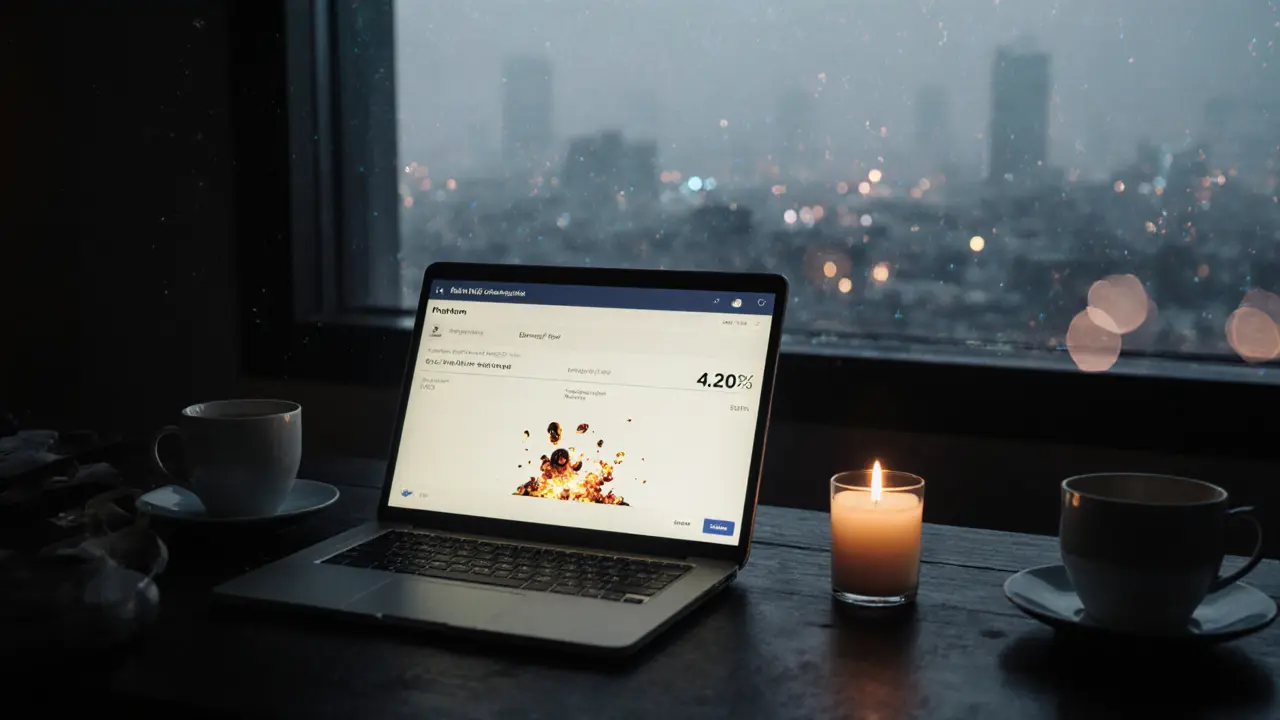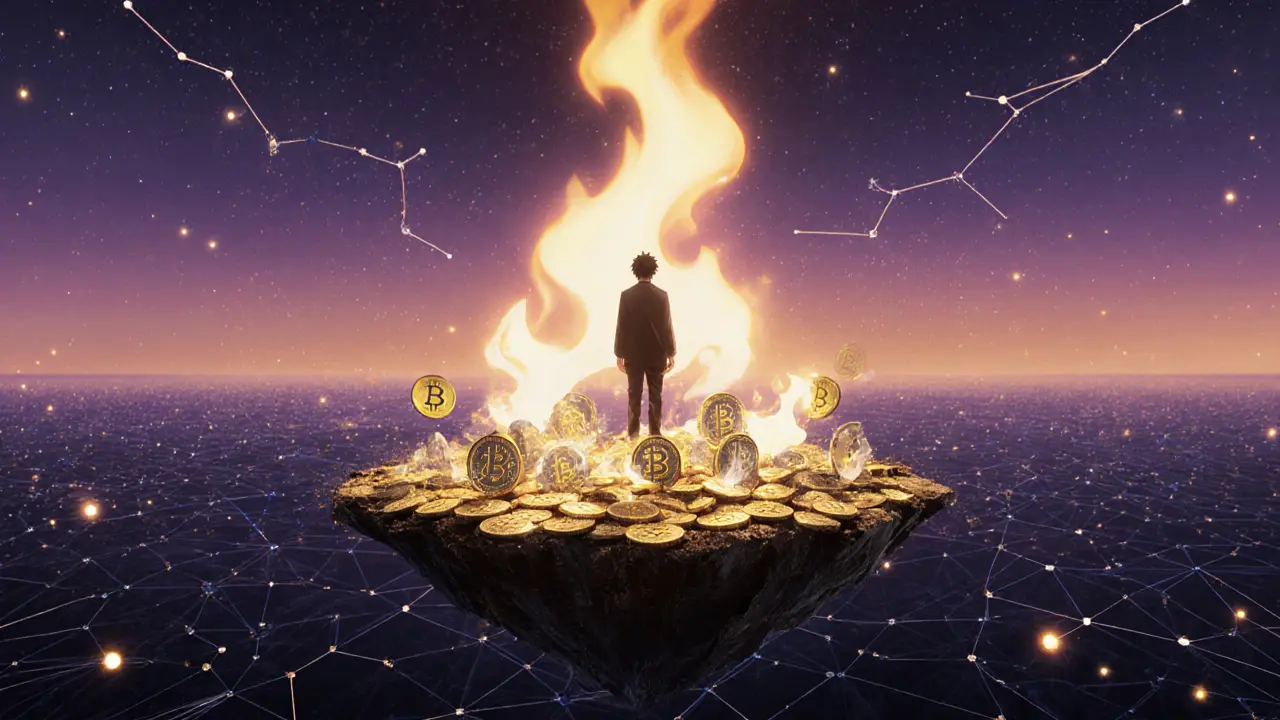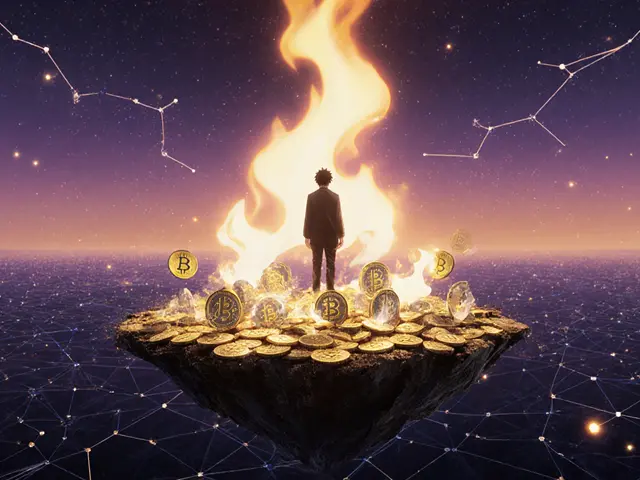Burncoin Transaction Calculator
How Burncoin Works
Every time you trade BURN, 4.20% of your tokens are permanently burned. This is a built-in feature of the Solana blockchain using Token Extensions. The more you trade, the faster the total supply decreases.
Important: This calculator shows the burn effect in isolation. In reality, small trades also face high slippage (up to 17.3%) due to low liquidity, making trades under $250 potentially very expensive.
Current price: $0.025644
Burn rate: 4.20%
Enter your trade amount to see the burn effect
Remember: This is a simplified calculation. In real trading, you'll also pay Solana network fees (typically $0.00025) and face slippage due to low liquidity.
There’s a new meme coin on Solana that’s making noise for one reason: it burns itself every time you trade it. Meet Burncoin (BURN). It doesn’t have a team, no venture capital backing, and no roadmap beyond a simple rule - 4.20% of every transaction gets destroyed forever. No refunds. No exceptions. That’s it.
On paper, it sounds like a clever twist on Bitcoin’s fixed supply. But in practice, Burncoin is a high-risk experiment wrapped in a catchy slogan: “a fiery sibling to Bitcoin, but made to burn.” If you’re wondering whether this is a smart investment or just digital pyrotechnics, here’s what you need to know - no fluff, no hype.
How Burncoin Works: The Burn Mechanism
Burncoin isn’t like most crypto tokens. Most tokens let you send and receive without losing any of your holdings. Burncoin changes that. Every time you send BURN to someone, swap it for another token, or even move it between wallets, 4.20% of the amount you’re transferring is permanently erased from circulation.
This isn’t done with a smart contract you can tweak later. It’s built into the Solana blockchain itself using Token Extensions, a feature that lets developers hardcode rules directly into the token standard. That means even if someone tried to hack the system or change the rules, they couldn’t. The burn is automatic, irreversible, and enforced at the protocol level.
With a total supply of exactly 21,000,000 BURN tokens, and no way to create more, this burn mechanism is the only thing controlling supply. The more people trade it, the faster the total supply drops. In the first 30 days, about 0.8% of all BURN tokens - roughly 168,000 coins - were already burned. That’s not much in percentage terms, but it’s a signal: this token only loses value through use.
Technical Specs: What Makes Burncoin Different
Burncoin runs on Solana as an SPL token. Its contract address is GQe8DCQTBkuX5E2sjvwuKDZsjGYhU8k3DN5dkSbQLfqJ, and you can verify every burn on Solana’s public ledger. You need a Solana wallet like Phantom or Solflare to hold it - no Ethereum wallets, no Binance Chain wallets. This isn’t a multi-chain project.
Transaction fees are low on Solana - usually under $0.00025 per transaction. But here’s the catch: you pay that SOL fee plus you lose 4.20% of your BURN tokens every time you move them. So if you send $10 worth of BURN, you’re not just paying a few cents in network fees. You’re also losing 42 cents in burned tokens. That’s a double cost.
That’s why users report problems. One Reddit user said their $50 swap cost $2.10 in burns and another $0.50 in SOL fees. For small trades, that’s a huge penalty. To keep slippage under 5%, you need to trade at least $250 worth of BURN. Most people don’t have that kind of capital to throw around.
Liquidity and Trading Reality
As of November 5, 2025, Burncoin’s total market cap is $457,600. That’s less than the price of a decent used car. Its 24-hour trading volume? Just $5,200. Compare that to SafeMoon, another deflationary token, which has $27 million in liquidity on PancakeSwap. Or even the average Solana meme coin, which trades over $1.2 million daily.
Low liquidity means big price swings. On trades under $100, slippage averages 17.3%. That means if you think you’re buying BURN at $0.025, you might end up paying $0.029 or more because there aren’t enough buyers and sellers to fill your order. CoinSwitch users reported this as their #1 complaint - 14 out of 17 reviews mentioned it.
And it’s not just about price. There are only 1,842 unique wallets holding BURN. Over 92% of the total supply is stuck in the top 10 wallets. That’s a red flag. If those big holders decide to sell, there’s no depth to absorb the dump. The price could crash overnight.

Utility? There Isn’t Any
Burncoin has no staking. No governance. No NFTs. No DeFi integrations. No partnerships. No app. No website with real content. Just a token address and a 3-paragraph description on Solana’s registry.
That’s the biggest problem. Other deflationary tokens like CAKE or SHIB at least offer something beyond burning. CAKE lets you earn rewards by staking. SHIB has a growing ecosystem with Shibarium, NFTs, and a decentralized exchange. Burncoin? Nothing. Just the burn.
Dr. Elena Rodriguez, Chief Cryptocurrency Analyst at CoinCodex, put it bluntly: “Burncoin’s fundamental flaw is the lack of utility beyond the burn mechanism itself - while mathematically sound, the token lacks the ecosystem integration seen in successful deflationary projects.”
And that’s the truth. You can’t use BURN to pay for anything. You can’t earn interest on it. You can’t vote on decisions. It’s not even used in any games or apps. It’s just a token that disappears when you move it. That’s not innovation. That’s a gimmick with a math formula.
Community and Support: Who’s Really Behind It?
Burncoin claims to be community-owned. But if you check its Telegram channel on November 5, 2025, there are only 12 active members. No announcements. No updates. No moderation. No team member ever responds.
On Reddit, people are asking questions like “Why is my trade taking 20 minutes?” or “Is this even real?” - and getting crickets. The only feedback comes from users who’ve already lost money.
There’s no official documentation beyond a few lines on Solana’s token registry. No whitepaper. No roadmap. No GitHub. No Twitter account with more than 500 followers. No YouTube videos explaining how to use it. If you’re new to crypto, you’re on your own.
That’s not decentralization. That’s abandonment.
Price Outlook and Risks
As of November 5, 2025, BURN is trading at $0.025644. That’s down 1.44% in the last 24 hours. CoinCodex’s forecast predicts it could drop another 25.37% to $0.01377 by November 27, 2025. Why? Because the Fear & Greed Index is neutral, volatility is extremely high (20.24%), and the 14-day RSI is at 38.88 - technically neutral, but not bullish.
Long-term, the outlook is worse. Solana blockchain researcher Alex Morgan said in a podcast: “Tokens without utility beyond tokenomics rarely last more than 18 months - Burncoin’s only advantage is the elegant burn implementation, but that’s not enough for sustainability.”
Industry reports from CoinMarketCap say pure deflationary tokens without utility are projected to shrink by 22.3% over the next two years. Meme coins that offer something - games, tools, services - are growing. The ones that just burn? They’re dying off.

Should You Buy Burncoin?
If you’re looking for a long-term investment, the answer is no. Burncoin has no future use case, no community support, and no liquidity. It’s a speculative gamble with a high chance of losing your money.
If you’re a crypto speculator with extra cash to throw at high-risk tokens, and you believe the burn mechanism will somehow create artificial scarcity that drives price up - then maybe you’ll try it. But don’t invest more than you can afford to lose. And don’t expect support, updates, or a refund.
The only real winners here are the early holders who bought cheap and sold high. Everyone else is just feeding the burn.
How to Buy Burncoin (If You Still Want To)
Here’s the bare minimum you need to do:
- Get a Solana wallet: Phantom or Solflare (both free and secure).
- Buy SOL on a centralized exchange like Binance or Kraken.
- Send SOL to your wallet.
- Go to a Solana DEX like Raydium or Jupiter.
- Swap SOL for BURN using the contract address:
GQe8DCQTBkuX5E2sjvwuKDZsjGYhU8k3DN5dkSbQLfqJ. - Remember: every swap burns 4.20% of your BURN. Trade in larger amounts ($250+) to avoid 15-20% slippage.
That’s it. No wallet setup guide. No customer service. No tutorials. You’re on your own.
Final Thoughts: A Technically Clever, Financially Risky Experiment
Burncoin isn’t a scam. It doesn’t have a team stealing funds. The burn mechanism works exactly as advertised. The code is transparent. The supply is fixed. The burns are real.
But that’s not enough. Crypto isn’t just about math. It’s about utility, adoption, and community. Burncoin has none of that. It’s a beautiful machine with no engine. A fire that burns without fuel.
If you’re drawn to it because of the “Bitcoin but burns” idea, remember: Bitcoin became valuable because people used it to send money, store value, and build systems around it. Burncoin has no such future. It’s a token designed to disappear - and so might your investment.
For now, it’s a curiosity. In six months? It might be a ghost.
Is Burncoin (BURN) a good investment?
No, Burncoin is not a good investment for most people. It has no utility, extremely low liquidity, and minimal community support. While its burn mechanism is technically sound, the lack of real-world use cases and high volatility make it a speculative gamble with a high risk of losing your money.
How does the Burncoin burn mechanism work?
Every time BURN is transferred, swapped, or moved between wallets, 4.20% of the amount is permanently destroyed and removed from circulation. This is enforced at the Solana blockchain level using Token Extensions, so it cannot be changed or reversed after launch.
Can I stake or earn rewards with Burncoin?
No, Burncoin does not offer staking, yield farming, governance, or any other form of rewards. It has no DeFi integrations, no app, and no roadmap beyond the burn mechanism. It exists purely as a deflationary token.
What wallet do I need to hold Burncoin?
You need a Solana-compatible wallet like Phantom or Solflare. Burncoin is an SPL token on the Solana blockchain, so it cannot be stored in Ethereum, BSC, or other non-Solana wallets.
Why is Burncoin’s price so volatile?
Burncoin has very low liquidity - only $29,000 in total across all exchanges. This means even small trades can cause big price swings. With only $5,200 in 24-hour trading volume, there aren’t enough buyers and sellers to stabilize the price, leading to slippage as high as 17-20% on small trades.
Is Burncoin regulated or safe from rug pulls?
Burncoin has no team, no centralized control, and no ability to mint new tokens - so it can’t be a rug pull in the traditional sense. However, its safety is limited to its code. With no community support, no roadmap, and minimal liquidity, it’s still a high-risk asset with little protection for investors.
How many Burncoin tokens are left in circulation?
The maximum supply is fixed at 21,000,000 BURN. As of November 5, 2025, approximately 17,850,000 BURN remain in circulation after about 3.15 million tokens were burned since launch. The burn rate continues with every transaction, so the circulating supply decreases over time.
Where can I check Burncoin’s real-time price and burns?
You can check live price data on Solflare, CoinGecko, or CoinMarketCap. To verify burns, use Solana blockchain explorers like Solscan or SolanaFM. Enter the contract address GQe8DCQTBkuX5E2sjvwuKDZsjGYhU8k3DN5dkSbQLfqJ to see all transactions and burn events on-chain.



Leo Lanham
November 6, 2025 AT 17:20This token is literally a firecracker with no fuse - you light it and wait for the boom, but nobody knows if it’ll just fizzle or blow up your whole portfolio. 4.20% burn? Cute. But if your only ‘utility’ is losing money every time you move it, you’re not investing, you’re just donating to a blockchain bonfire.
Whitney Fleras
November 8, 2025 AT 02:03I appreciate the no-fluff breakdown. It’s rare to see someone lay out the cold truth without hype. Burncoin’s mechanics are clever, but clever doesn’t mean sustainable. If you’re not using it for anything, why hold it? Just my two cents.
Colin Byrne
November 9, 2025 AT 10:42While it’s true that Burncoin lacks traditional utility, one must consider the philosophical implications of a token designed to self-annihilate with each transaction. In a world saturated with speculative assets that inflate through artificial demand, this is a radical act of economic minimalism - a digital austerity measure. The market may not yet understand it, but history often rewards those who anticipate the inevitable collapse of excess. This isn’t a coin - it’s a protest against the entire meme coin ecosystem.
Brian Webb
November 9, 2025 AT 16:42Some people are calling this a scam, but it’s not - it’s just brutally honest about being useless. No team hiding behind a whitepaper, no promises, no roadmap. Just a math rule and a warning label. I respect that. But I also wouldn’t touch it with a 10-foot pole unless I was ready to lose it all. It’s like buying a watch that only ticks for 30 seconds before stopping - pretty cool design, but what’s the point?
Vipul dhingra
November 10, 2025 AT 09:10Jacque Hustead
November 12, 2025 AT 05:21It’s interesting how some people see this as a failure, while others see it as a statement. Maybe Burncoin isn’t meant to be held - maybe it’s meant to be traded quickly, burned, and forgotten. Like a digital firework. Not every token needs to be a utility coin. Some are just art.
Wendy Pickard
November 13, 2025 AT 01:54Reading this made me realize I’ve been chasing ‘the next big thing’ without asking what ‘big’ even means anymore. Burncoin doesn’t try to be Bitcoin. It doesn’t try to be DeFi. It just… burns. And maybe that’s enough for some people. Not me - but I get it.
Jeana Albert
November 14, 2025 AT 13:16Wow. So you’re telling me this is a token that literally destroys your money every time you try to use it? And people are seriously considering this as an investment? This isn’t crypto. This is a psychological experiment on gullible people who think ‘deflationary’ means ‘profitable.’ If you’re dumb enough to buy this, you deserve to lose it. No sympathy.
Angie McRoberts
November 15, 2025 AT 18:12So… Burncoin is the crypto equivalent of a single-use plastic bottle that’s also on fire? You hold it, you feel the heat, you think it’s cool - then you realize you’ve got nothing left but ash and a bad smell. I’ll pass. But hey, at least it’s honest about being a dumb idea.
Leo Lanham
November 15, 2025 AT 23:47And yet… someone bought it. And someone else sold it for 3x. That’s the real story. Not the burn. Not the utility. Not the code. It’s the fact that somewhere, someone thought this was a good idea - and got paid for it. That’s the meme. Not the token. The human.